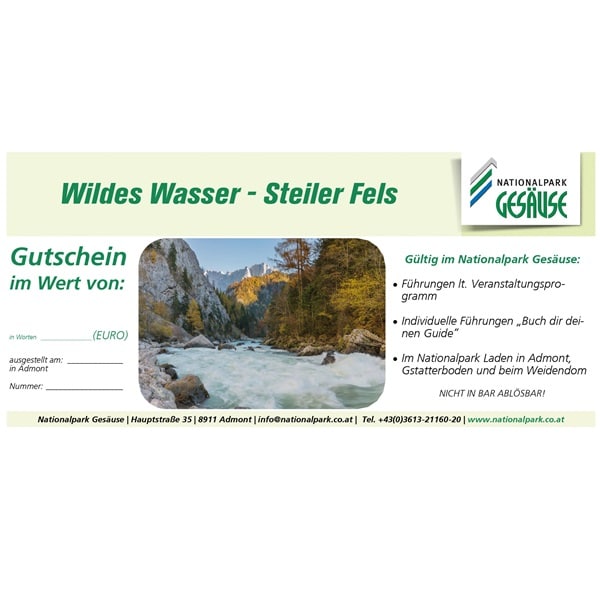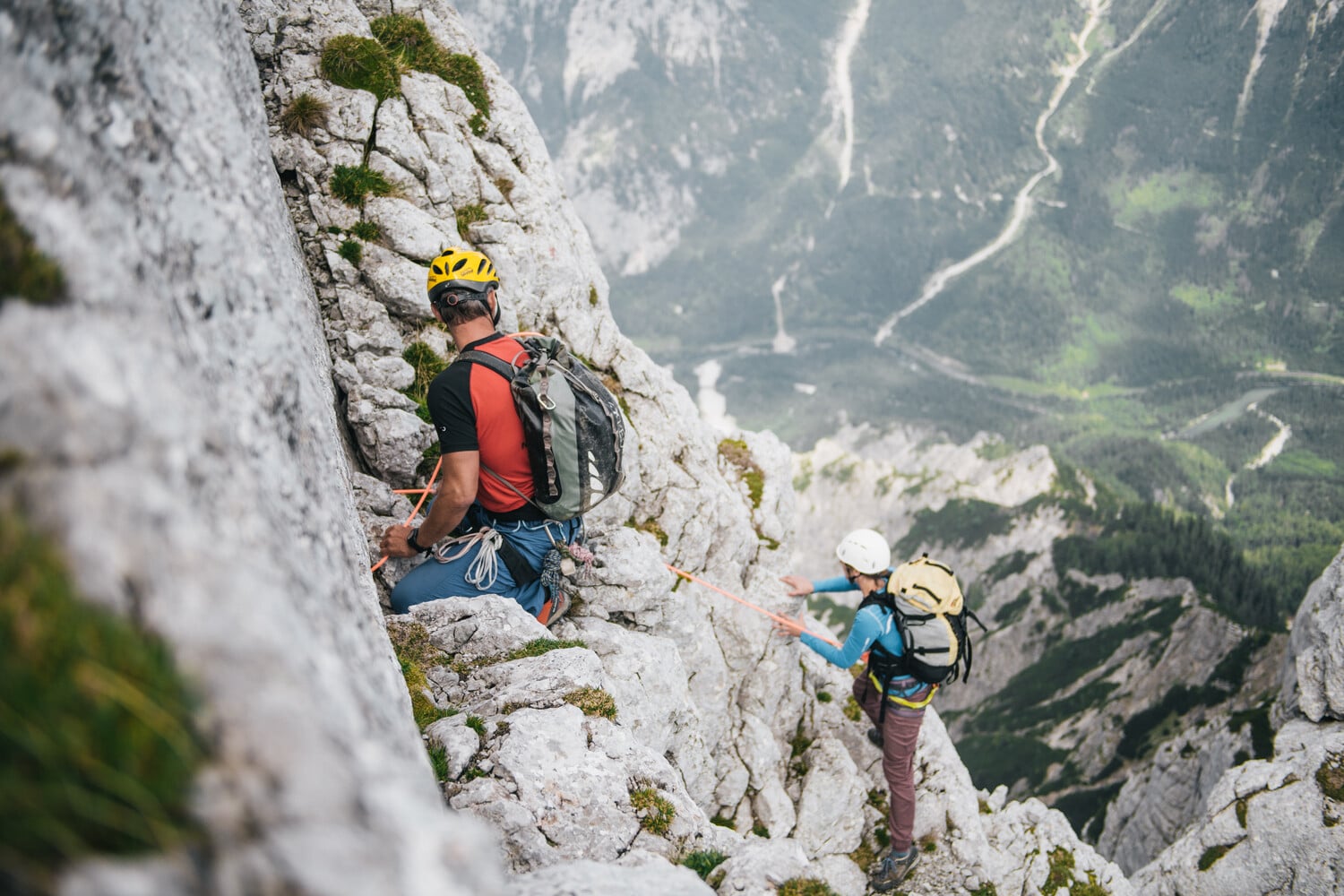
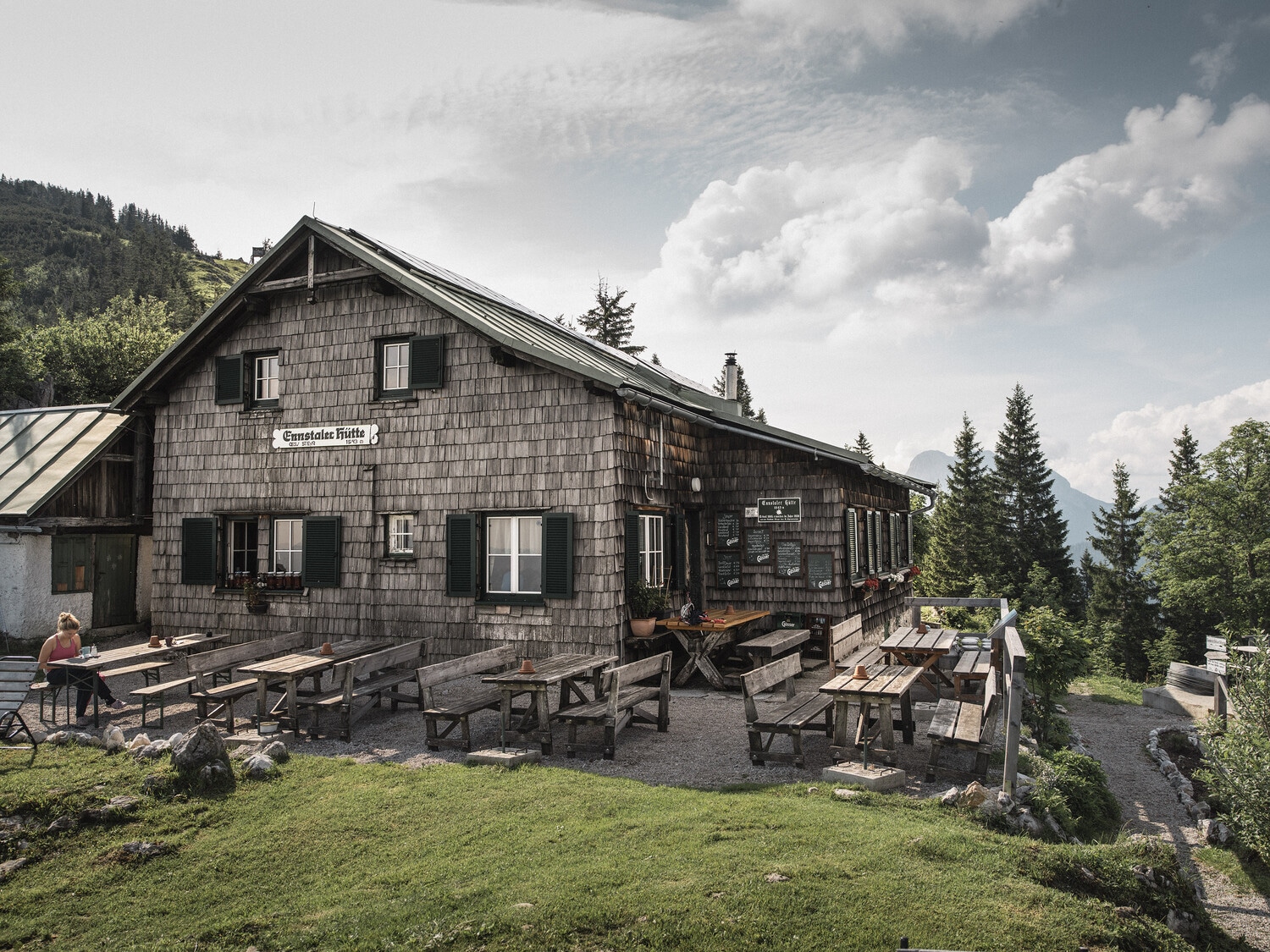
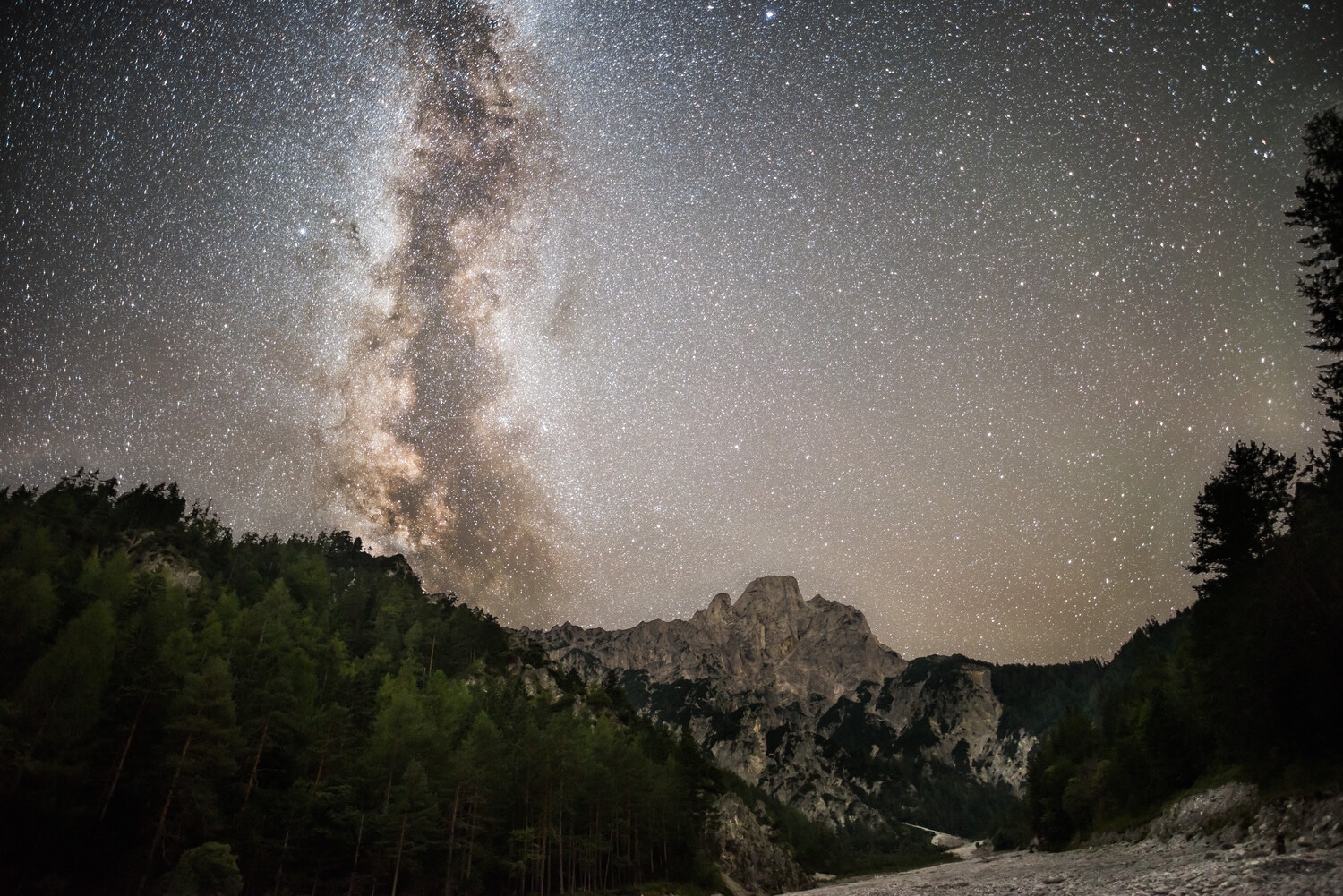
19.12.2018
On the second weekend of Advent this year, Advent in the Weidendom in the Gesäuse National Park took place for the 14th time.
Despite continuous rain on Sunday, around 1,600 people were able to get in the mood for Christmas with performances by the Ardning and Weng folk schools, Christmas brass music by the Weng music band and various culinary and handicraft specialities. The children also had fun doing handicrafts and decorating gingerbread.
This year, special thanks go to the sponsors and the volunteers who helped spread the wood chips.

19.12.2018
Trees with distinctive gnaw marks are a trademark for the beaver. Since 2013, there has been evidence in the vicinity of the National Park of these European rodents migrating from the Enns Valley in Upper Austria. They overcome the barrages and rapids by choosing a comfortable footpath over land. Beavers have been present in the Styrian Enns Valley for some time. Now it looks like the first one has also made itself at home at the reservoir of the Kummer power plant not far from Gstatterboden - with an excellent view of the Planspitze.
Photo: Alexander Maringer
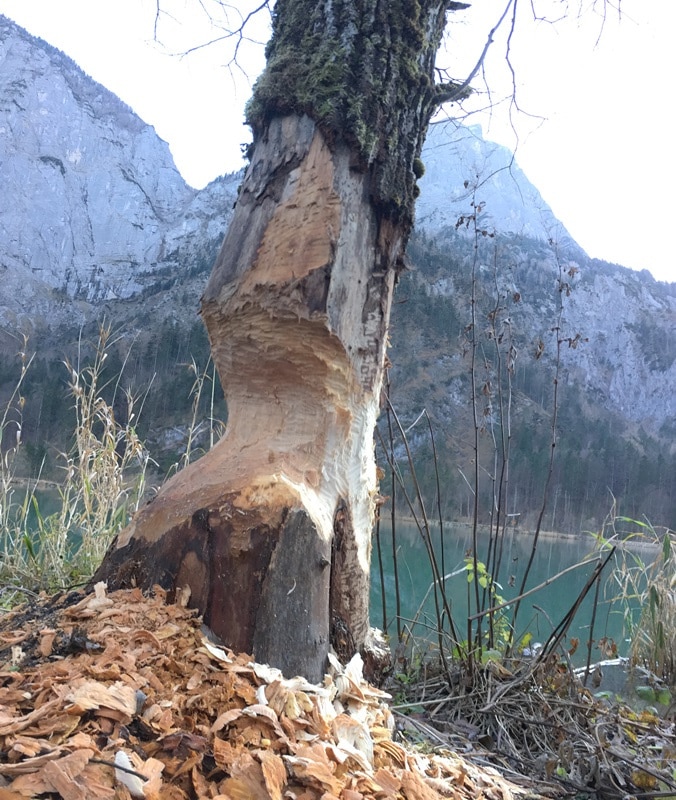
28.11.2018
The Gesäuse Photo School presented the current course programme for 2019 at the Photo+Adventure in Vienna (24-25 November)! Untouched nature in the Gesäuse National Park and photography - arguably a perfect combination. The demand for the courses was enormous and so some courses are already fully booked. And so we are already looking forward to next year's Photo+Adventure.
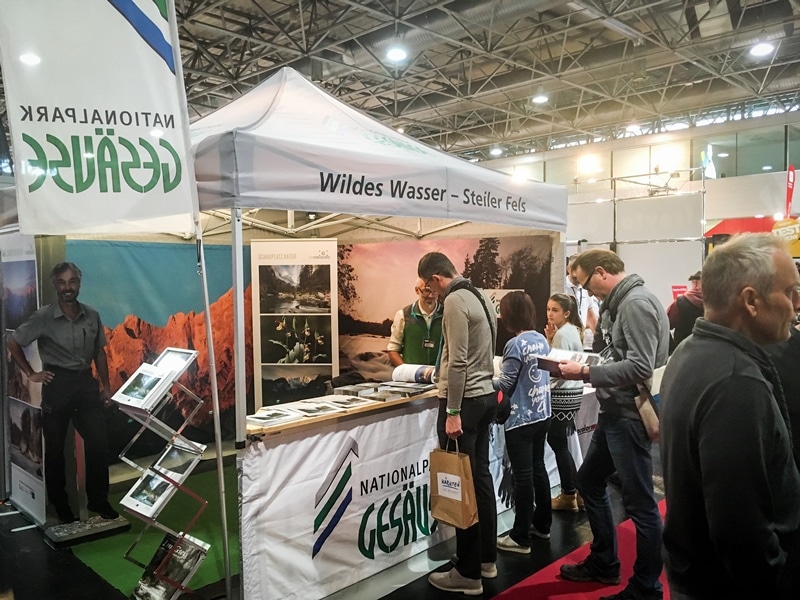
07.11.2018
Offspring of the lynxes! Since this year, a young animal has been tracking its tracks through the forest wilderness. In the Oberlaussa area, lynx expert Christian Fuxjäger has confirmed a cub. After years without offspring, there is finally a kitten again to support the lynx population!
The Lynx Trail - on the tracks of the lynx through "Austria's Wild Middle" is now bookable online!
Learn more here: www.luchstrail.at
Book here: https://www.bookyourtrail.com/trail/luchs-trail

25.10.2018
The Sulzkarsee on the alpine pasture of the same name is the largest still water in the Gesäuse National Park with 2 ha. Originally a fish-free lake, it was stocked with fish in the 20th century. Over the course of time, the biology of this body of water has changed completely. A paradise for amphibians turned into a lake with a high nutrient content and dominated by aquatic plants. With great effort, the National Park has now succeeded in renaturalising the lake by completely fishing out the minnows (Phoxinus phoxinus). The small minnows were able to reproduce in the lake, but the lake was never suitable for the natural reproduction of larger fish. There will be a detailed information lecture on 10 January 2019.
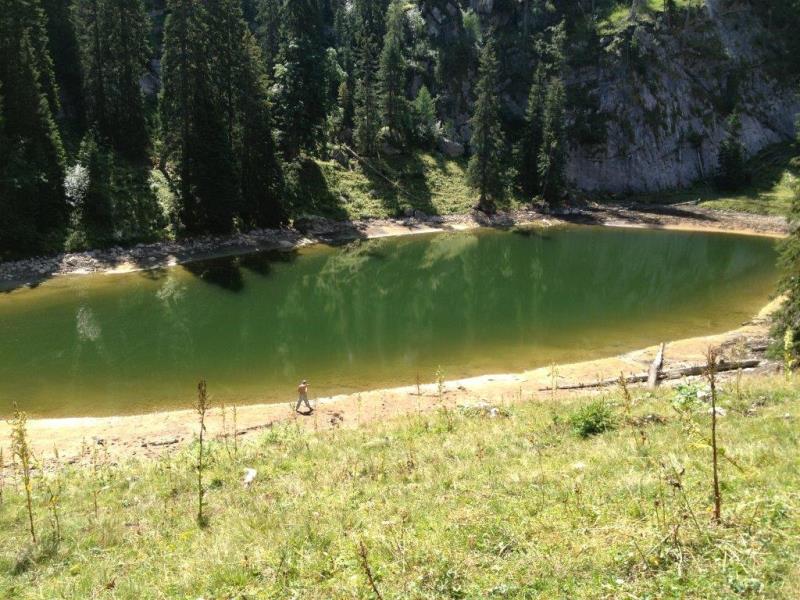
25.10.2018
As part of a company outing, employees and rangers of the Gesäuse National Park spent a day in the Sölktäler Nature Park. Veronika Grünschachner-Berger, wildlife biologist and project manager in the nature park, explained the work in the nature park and guided them through its wonderful landscape. The power plant, whose intermittent operation in the form of hydropeaking is having an impact as far as the Gesäuse National Park, was discussed and what cushioning measures could be taken. Other topics were alpine farming, which is threatened by various factors, wildlife habitats and also tourism. While a national park largely disposes of its land, in the nature park projects can only be carried out together with the landowners. The nature park lives with and through the landowners. This is the great challenge for the nature park management.
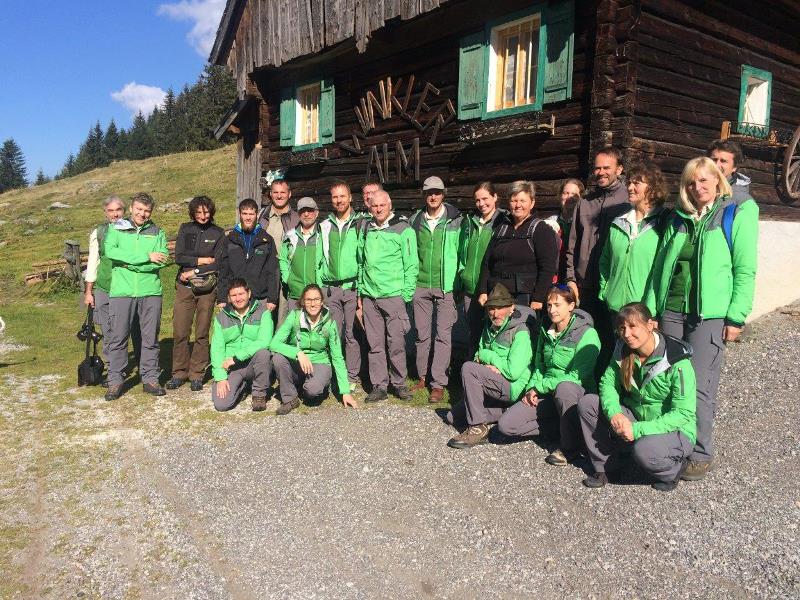
17.10.2018
On 5 October 2018, it was that time again. The primary school in Hall and the Gesäuse National Park joined forces. Everyone celebrated this joyful day together with song and dance. It is now the 6th National Park partner school (incl. 2 partner kindergartens) in the region - the network is growing and growing and growing! For us it is nice to see that the educational institutions of the National Park communities are increasingly interested in cooperating with the National Park. The cooperation is an absolute enrichment for both sides. The schools are offered a comprehensive and well-founded environmental education programme, and the National Park benefits from an increasing acceptance among our youth.
We look forward to a successful cooperation!
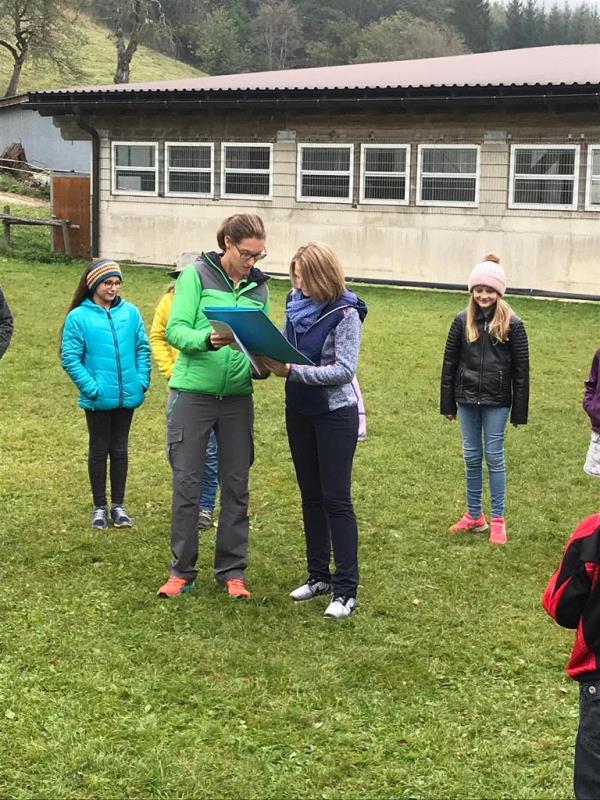
16.10.2018
25 years of Climate Alliance at the Rio Negro - partners from Brazil reported on successes of the long-standing partnership and threatening dangers for the Amazon rainforest.
Admont, 9 October. There was double reason to celebrate during the visit of the Climate Alliance partners from the Amazon rainforest. On the one hand, the 25th anniversary of the partnership with the Climate Alliance municipalities in Austria and, on the other hand, the further expansion of the rainforest protection area. The municipality of Trofaiach has been a Climate Alliance municipality since 1995 and since then has supported indigenous peoples on the Rio Negro in their efforts to protect the rainforest. Andreas Hollinger from the Gesäuse National Park welcomed Marivelton Rodrigues Barroso, President of the umbrella organisation of over 90 indigenous organisations on the Rio Negro, and the anthropologist Renato Martelli Soares. The Brazilian delegation was given an insight into the Gesäuse National Park and was particularly interested in soft tourism.
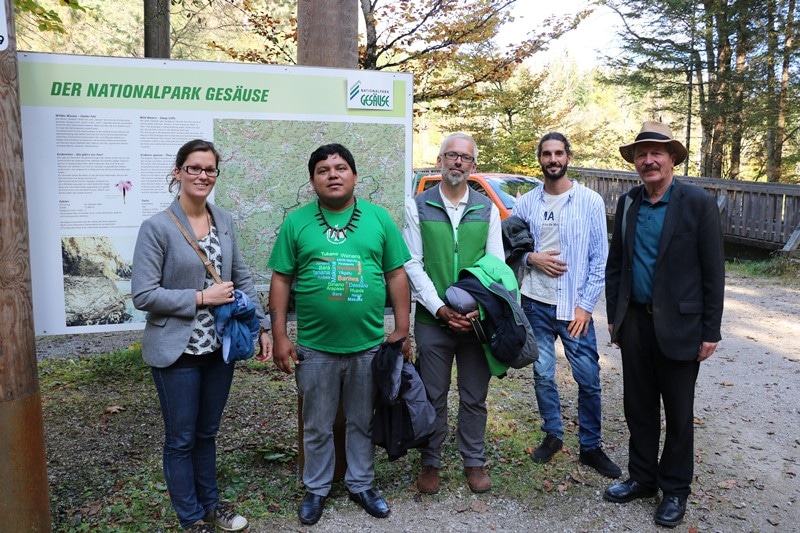
10.10.2018
Between 5 and 7 October 2018, the Gesäuse Tourism Association and Gesäuse National Park invited visitors to the second "Expedition_Heimat". What is it all about? Exploring the Gesäuse's homeland identity space and developing scenarios for its future - with and through the local people. Three hikes in the communities of Admont, Landl and St. Gallen got the thoughts flowing.
The discussion about approaches to local development in Hieflau was particularly exciting and concrete, where Deputy Mayor Franz Hannes Mayer showed the potential of his home town. Students from the Graz University of Technology under the direction of Prof. Wolfgang Dokonal contributed suggestions. Jens Badura (www.bergkulturbuero.org) provided food for thought and discussion.
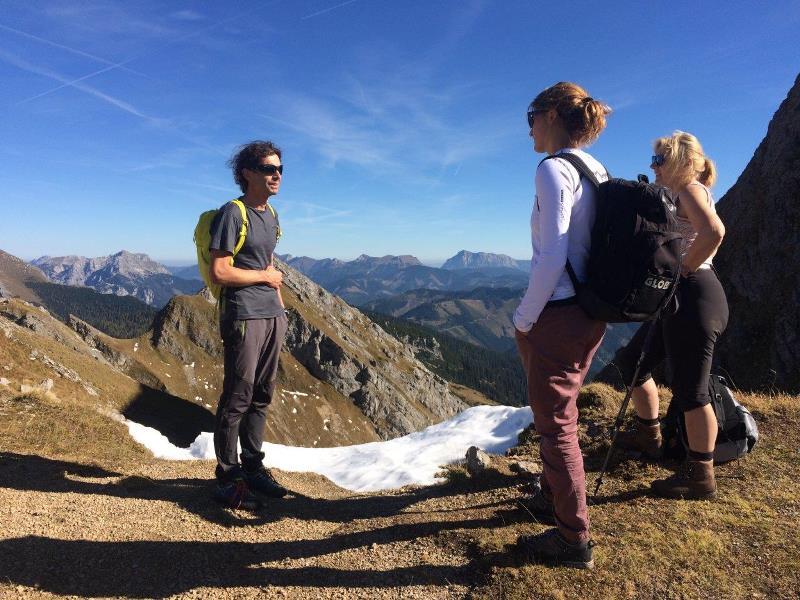
10.10.2018
A meeting of representatives of the nature conservation departments of the Länder (private meeting of joint Länder representatives in various specialist areas, which has been held annually in a different province each year for 22 years) took place in the Gesäuse National Park from 28.9-30.9.2018. Ten participants from almost all federal provinces in Austria were able to take a closer look at the nature conservation work of the Gesäuse National Park in bright weather.
After a welcome at the Weidendom adventure centre, an excursion along the Johnsbach and into the Gseng marvelled at renaturation measures and their positive effects on nature. Along the Rauchboden Trail, the measures in the National Park forest could be discussed with National Park Director Herbert Wölger. The goal of natural development in the natural zone can now be achieved even better after the recent designation as a biotope protection forest. As a crowning finale, the group visited Admont Abbey with its library and the worthwhile natural history collection including the National Park exhibition "Passion for Nature".
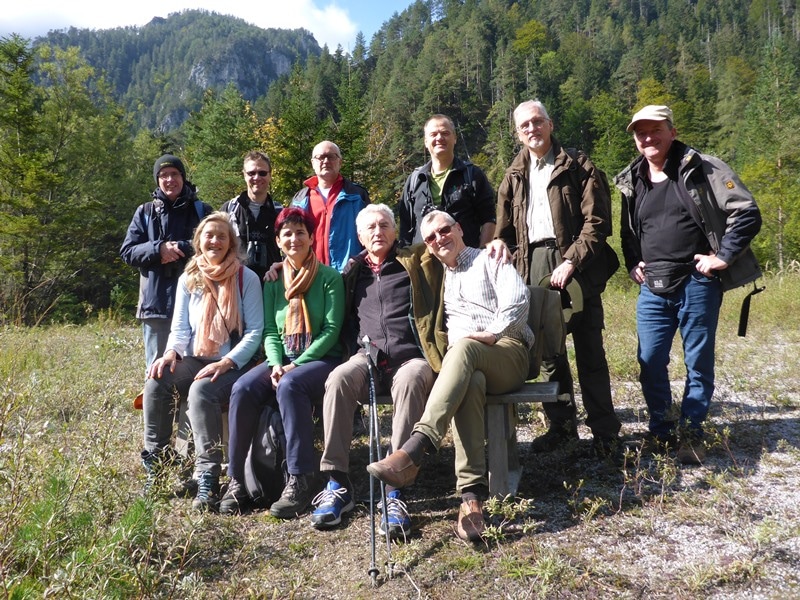
27.09.2018
Springs in the Gesäuse National Park have been systematically researched since 2003. Volume 15 of the Gesäuse National Park's publications was published in time for "World Water Week" and presents updated results of the research that has now been going on for 15 years. 66,000 organisms have been studied, dozens of new species have been identified for Austria and even previously completely unknown species have been newly described.
http://www.nationalpark.co.at/de/forschung/schriftenreihe
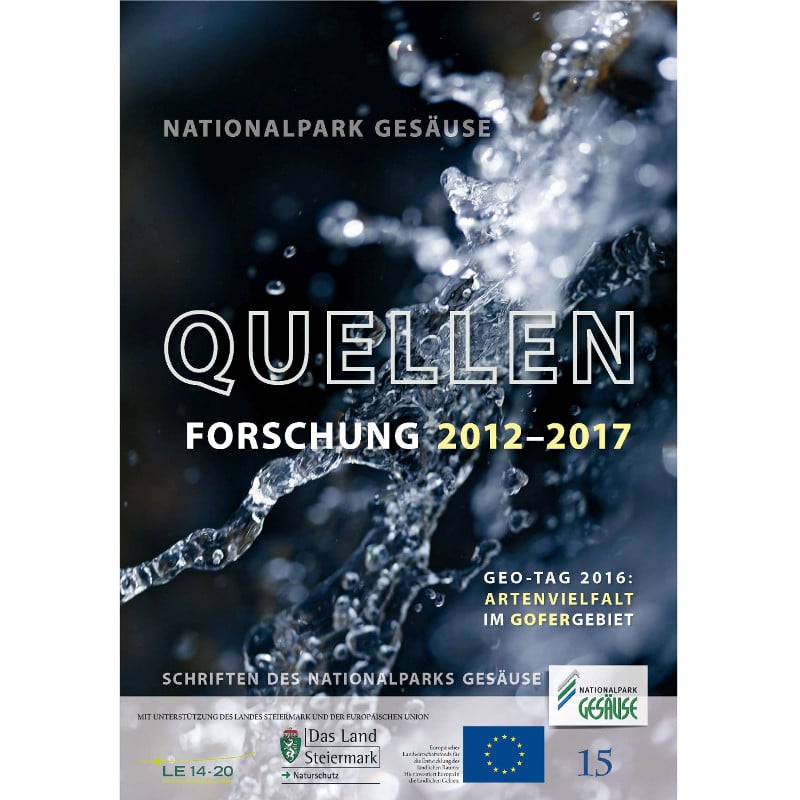
27.09.2018
THE GESÄUSE NATIONAL PARK IS PART OF EUROPEAN COOPERATION IN NATURAL SCIENCE!
Recently, the European Strategy Forum on Research Infrastructures (ESFRI) decided to establish a European infrastructure for long-term ecological research (eLTER RI), in which the National Park will also participate. For the Gesäuse, this will result in exciting cooperation with other European research locations in the future. The combination of environmental monitoring and biodiversity research is particularly interesting. This should make research into complex interrelationships that are of global significance (e.g. the effects of climate change on humans and nature) a little easier or more efficient.
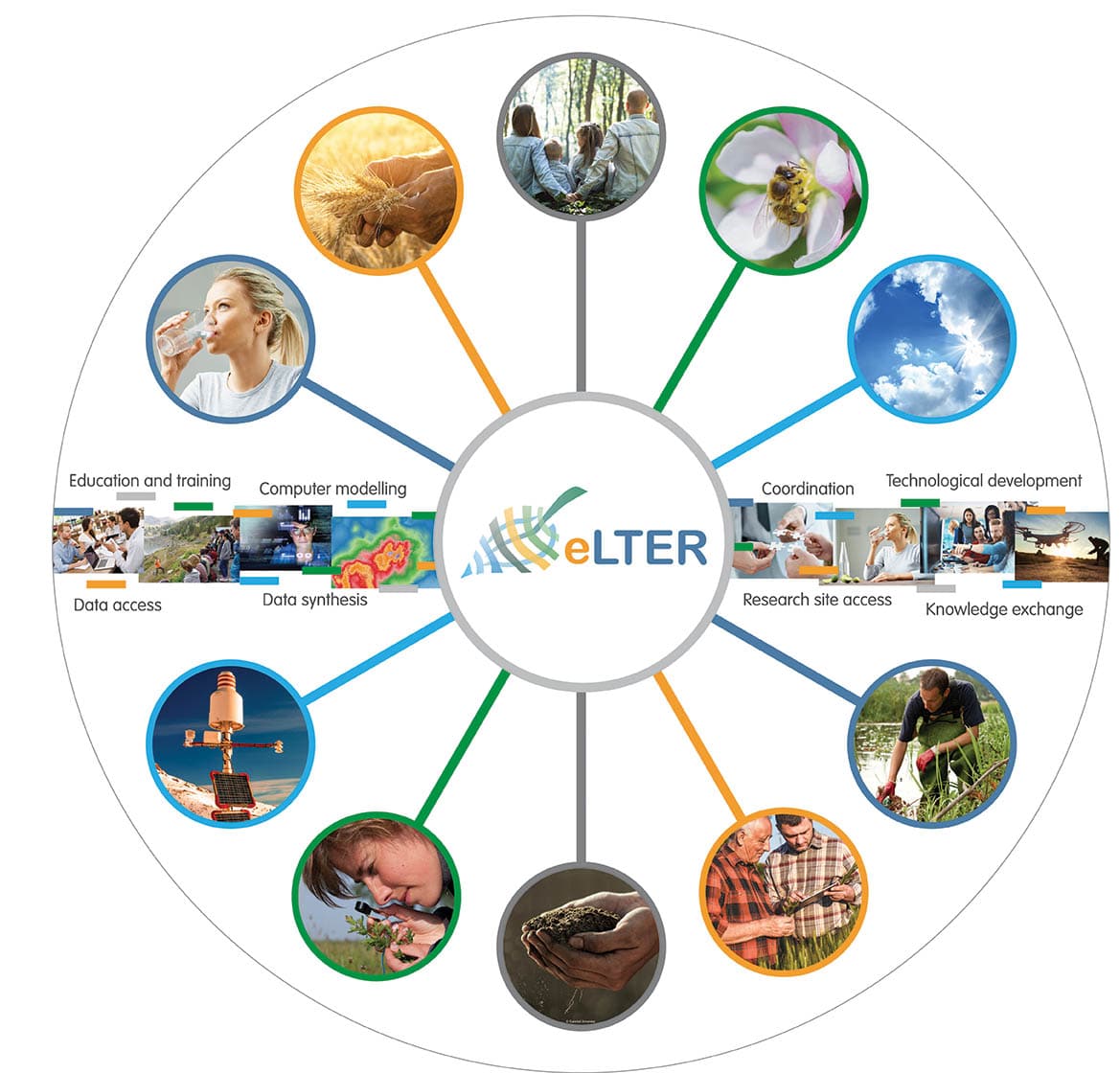
06.09.2018
A few days ago, a motivated group consisting of National Park staff, rangers and volunteers met to clean the Gesäuse of litter.
Due to the low water level of the Enns this year, the gravel banks and the accumulations of driftwood were particularly easy to reach. In addition, with the support of the outdoor company Strobl, who once again provided us with a raft boat and a guide who was keen on collecting rubbish, we were able to reach the gravel islands and banks that were inaccessible on foot.
In just 4 hours, 24 bags of rubbish, 2 car tyres, several indefinable pieces of metal and half a dustbin were removed from circulation and properly disposed of by 17 people.
But not only rubbish, also neophytes are stranded on the banks of the Enns after a flood. In the course of the Xei cleaning, a large occurrence of Japanese knotweed was removed. Since even individual leaves left lying around can take root again, extreme care must be taken when pulling out this invasive neophyte. The result: a neophyte-free section of the riverbank and 19 rubbish bags full of knotweed!
Afterwards, a toast was raised at the National Park Pavilion in Gstatterboden to the successful cleaning campaign.
Thank you to all helpers for your commitment to a "Clean Xeis"!
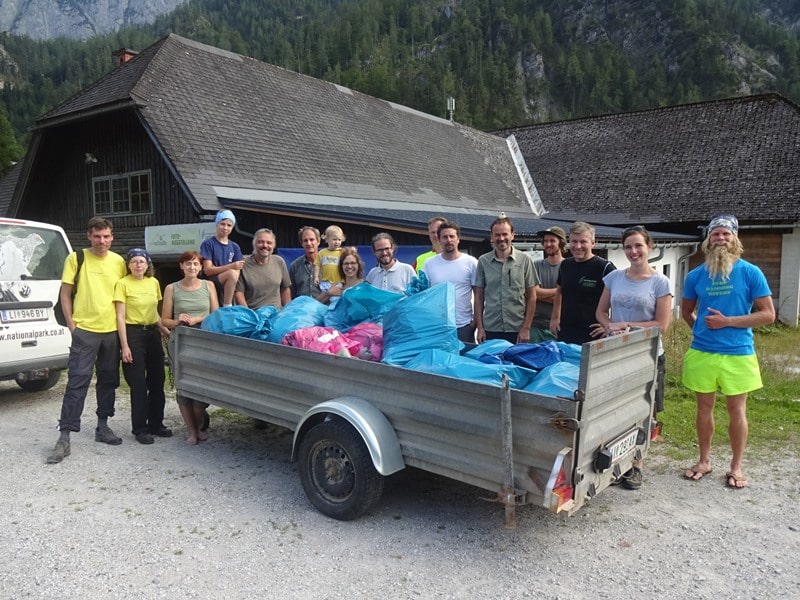
06.09.2018
s early as the Bronze Age, 3,500 years ago, copper was mined in Johnsbach. Josef Hasitschka has investigated which technology was used at that time and which places bear witness to mining and compiled it in a book including a hiking guide.
The first ascent of the "new" Johnsbach Copper Trail from Radmer to Zeiringer Alm took place on 1 September. Rest benches were set up at notable trailheads. Thanks are due to the forestry administrations Steiermärkische Landesforste and Franz Hohenberg.
What is remarkable about these waypoints can be read in the book. Walking time 3 hours, several refreshment stops at alpine pastures and can be combined with a visit to the Paradeisstollen exhibition mine www.kupferschaubergwerk.at .
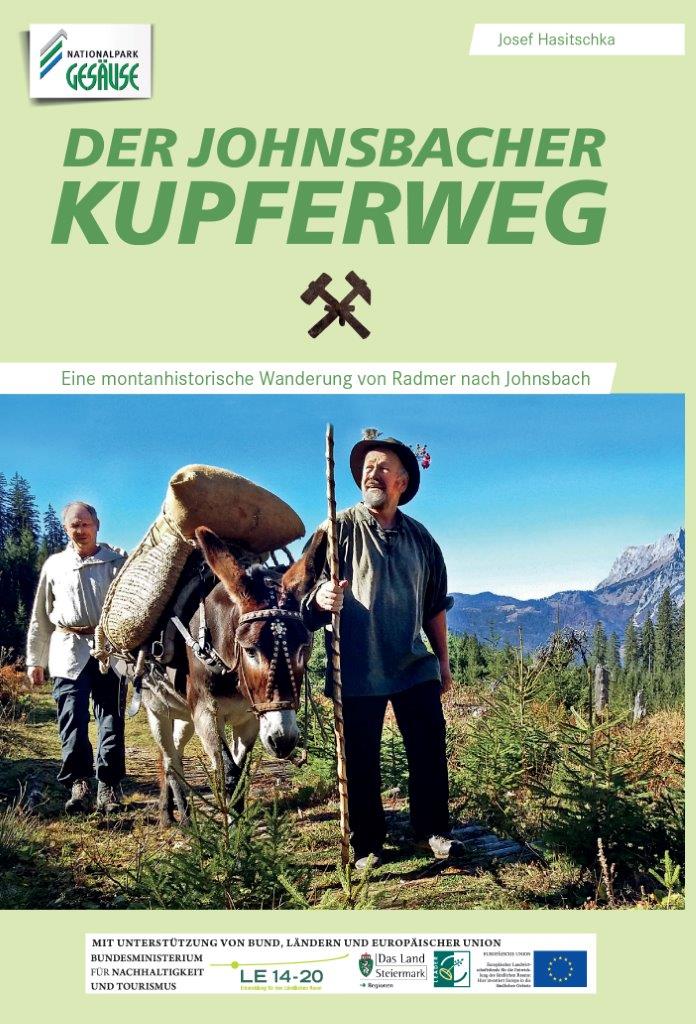
27.07.2018
3 days, 19 Junior Rangers, 1 cave expedition, 1 alluvial forest exploration, 1 mountain stream discovery, 1 camouflage and deception - these are this year's Junior Ranger Days in facts and figures.
Joy, fun, new friendships, overcoming, pride, curiosity, motivation, (hunger for) knowledge, surprise, spirit of research, effort, reward, ticks, nature experience, excitement - these are the keywords that best describe this year's Junior Ranger Days. It was beautiful!
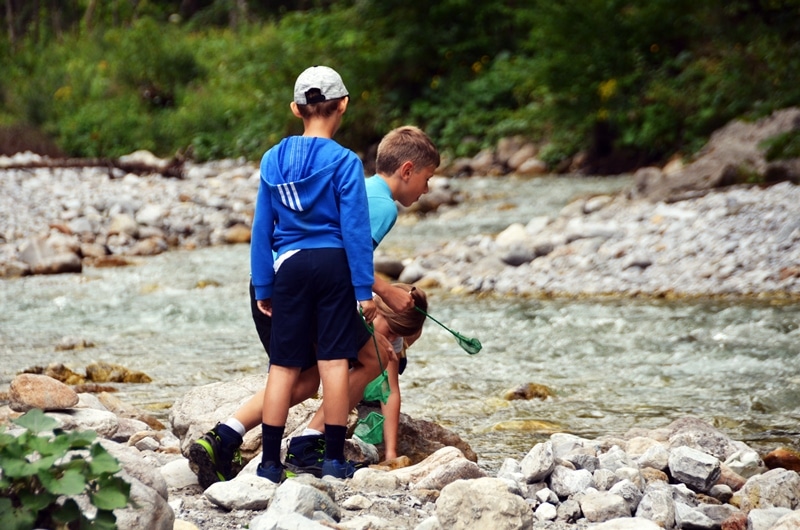
27.07.2018
The lynx is a symbol of the mysticism of wilderness. The Lynx Trail follows the ecological stepping stones created for it, which today - in Austria's geographical centre, the border triangle of Upper Austria, Styria and Lower Austria - form its habitat. Along these stepping stones, the Kalkalpen and Gesäuse National Parks, the Styrian Eisenwurzen Nature Park and the Dürrenstein Wilderness Area, the presence of the lynx is noticeable but mostly not visible. The Lynx Trail leads 200 km on hiking trails through this area and - it will be bookable from 2019. An Explorer Tour will give a foretaste in September. For participants of the Explorer Tour there are extras, such as hand tracking of lynx with a National Park Ranger.
Info and booking here: https://blog.bookyourtrail.com/allgemein/explorer-tour-am-luchs-trail

26.07.2018
The German tamarisk reintroduced to the National Park in 2017 is developing splendidly! Now the aim is to further increase the population of this species, which is extinct in the Gesäuse, and to increase the genetic diversity. For this purpose, seeds were collected from the northern catchment area of the Danube again this year, just like last year. Employees of the Gesäuse National Park and the Danube Floodplain National Park therefore travelled to Elmen in the Tyrolean Lech Nature Park and harvested the shrubs that still occur naturally there. In the meantime, the seeds have been handed over to the HBLFA Raumberg-Gumpenstein for cultivation. With a bit of luck, they can be planted again next year along the Enns and Johnsbach rivers.
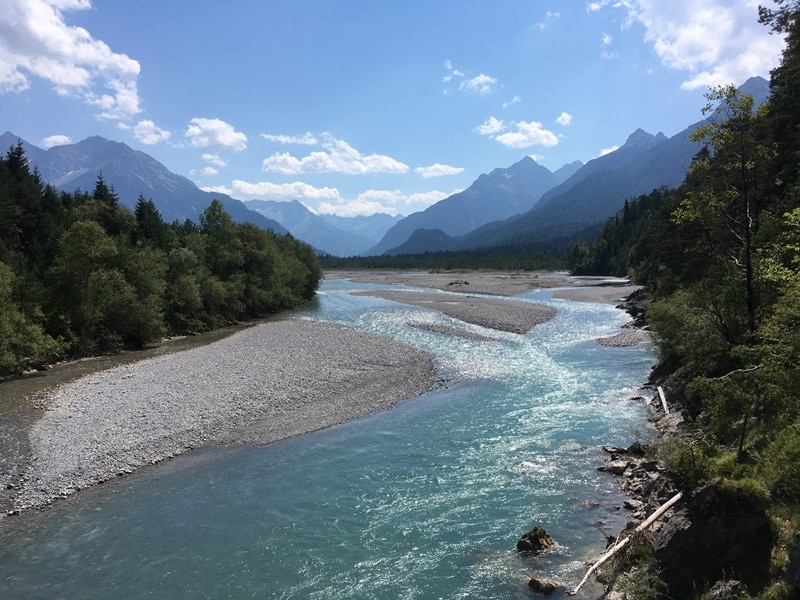
19.07.2018
This year, the "Youth on the Summit" event took place for the 4th time, and the Gesäuse National Park was there again. At the ranger camp, climate change was tackled. 12 young people from the region dealt creatively with the effects of climate change and considered together where and how energy can be saved. We ended the two adventurous days at the Ennstalerhütte. The young people's conclusion: "It was far too short - longer next year, please!
Many thanks to ALPARC for their support. More information on Youth at the top at: www.youth-at-the-top.org
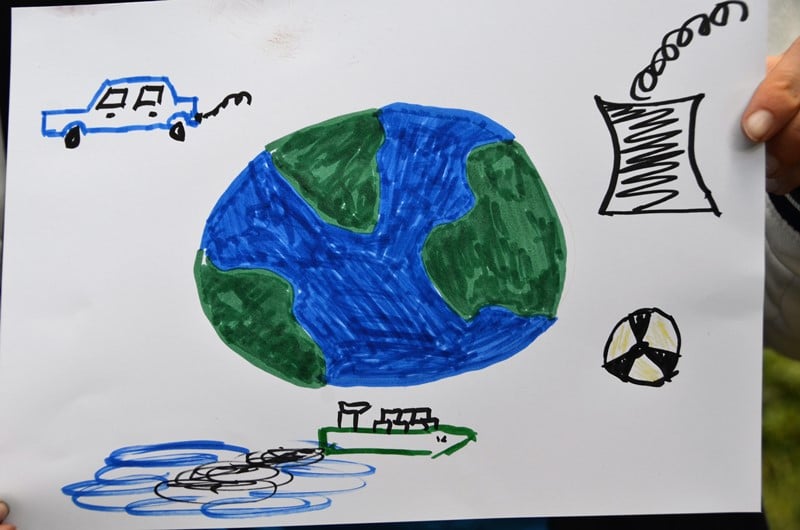
12.07.2018
National parks and other protected areas are known worldwide for their breathtaking landscapes, exciting visitor attractions and commitment to conservation. Often overlooked is the important contribution that protected areas make to research. National parks are important drivers of practical research.
Which topics are being researched in the Austrian National Parks can now be looked up at www.parcs.at. Among others, the contributions of the last National Parks Austria Research Symposium in 2017 have recently been published. 230 researchers from 19 countries presented their research results. This resulted in 213 articles, which were summarised in the conference proceedings.
Research Symposium 2017: http://www.parcs.at/npa/mmd_fullentry.php?docu_id=35476
Photo: Christian Fürnholzer
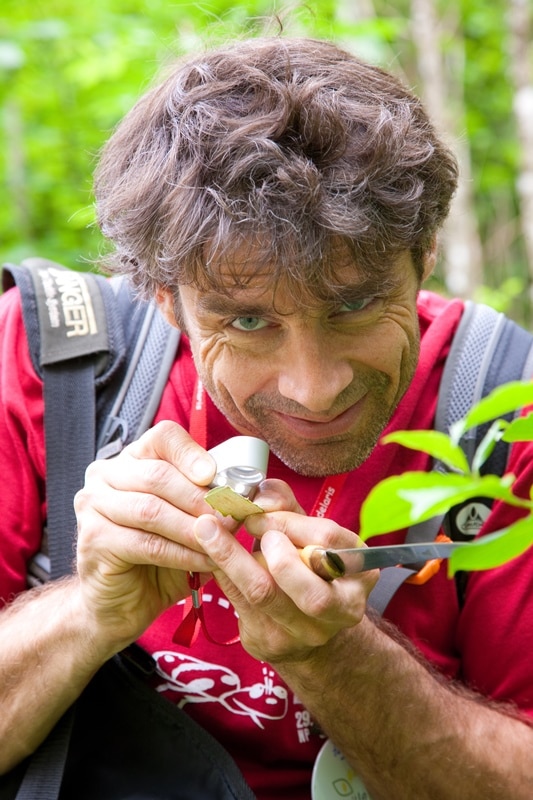
11.07.2018
Once again, the Ladies Photo Weekend took place in the Gesäuse National Park at the beginning of July. Photographer and workshop leader Christine Sonvilla had come up with something new this time: Instead of setting out from Admont to the Gesäuse area as before, this time we went up high.
The base for the ladies' weekend was the Haindlkarhütte, from where it is only a hop, skip and a jump to the Gsengscharte. Climbing was not on the agenda, but getting up early to catch the first morning rays stealing over the Gsengscharte was. The tired eyes were also quickly gone when the sky presented itself in a splendid blue dress, the surrounding rocks magically bathed in the first light and the wafts of mist drifted up from the valley. "It was really fun to be out and about with such a motivated and photo-loving group of women," says Christine.
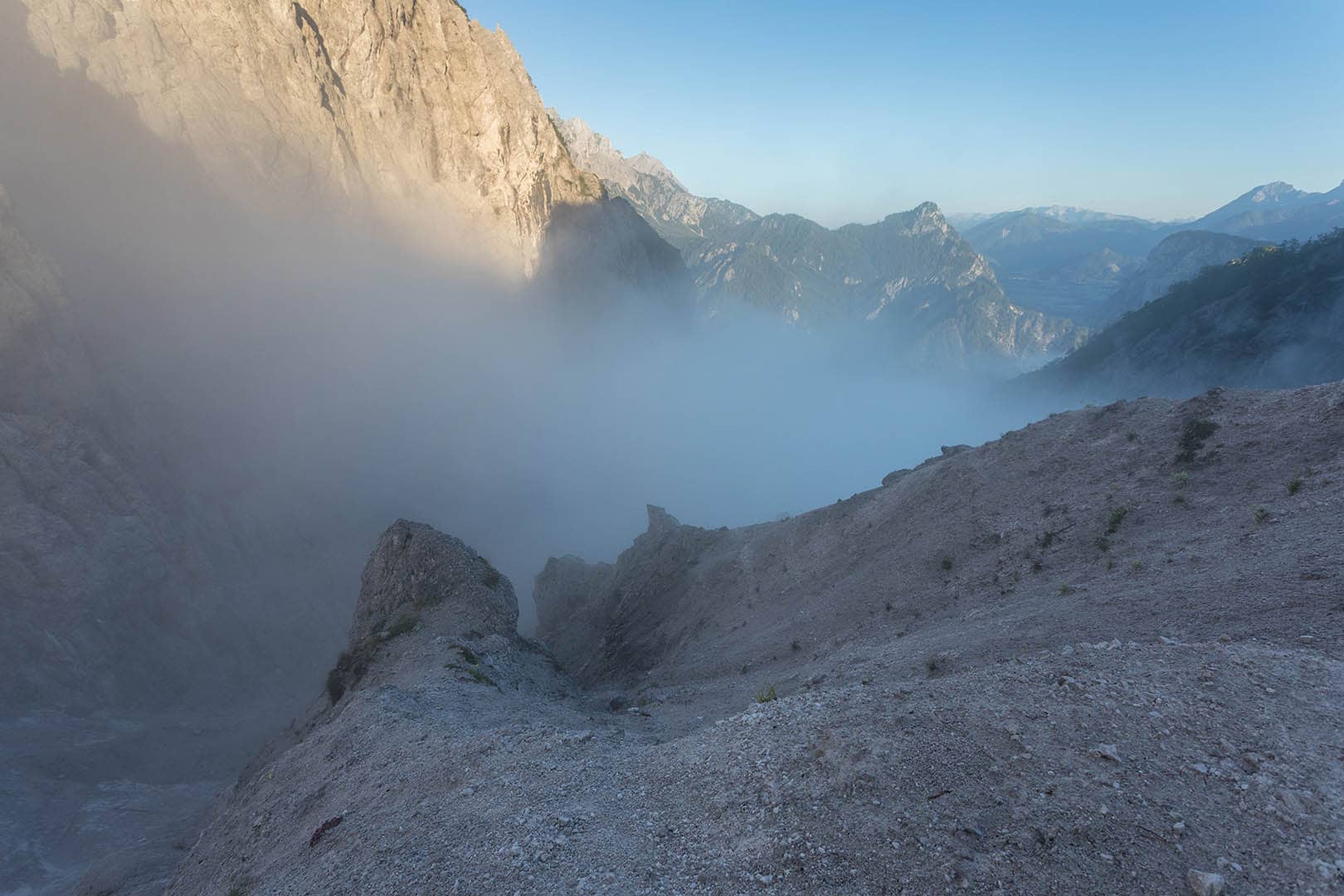
06.07.2018
The two 4th grade classes of the Admont NMS ended their four-year Junior Ranger training in the Gesäuse National Park with a final trip to the Hohe Tauern National Park. The three eventful days included an ascent of the glacier forefield of the Pasterze with a view of Austria's highest mountain, the Großglockner, a hike to the Innergschlöß and a visit to the House of Water. The pupils of the NMS were visibly enthusiastic and give this final trip the rating "highly recommended".
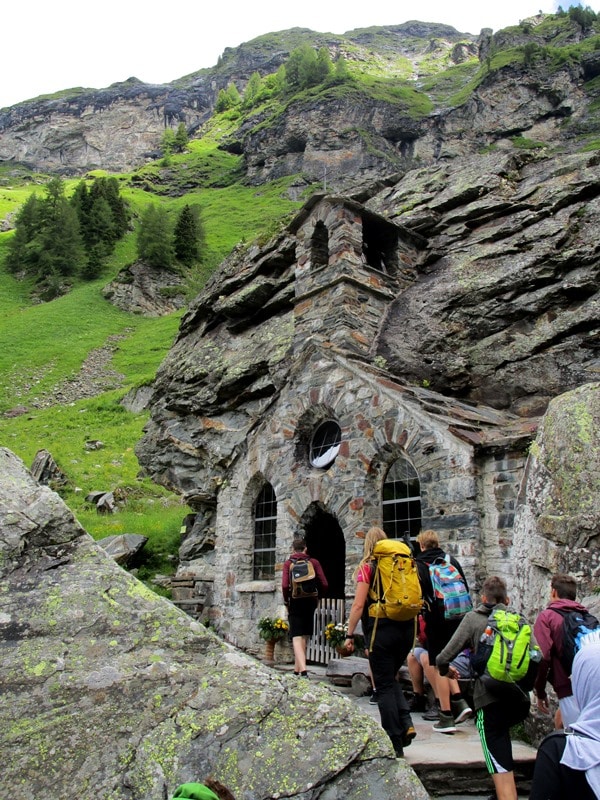
29.06.2018
This year's LTER Austria Annual Conference (Austrian Society for Long-Term Ecological Research) took place in the Gesäuse National Park and in Admont (Hotel Spirodom) from 25.6-26.6.2018. 30 participants from almost as many research sites in Austria presented ongoing research projects and discussed the future of long-term research in Austria and Europe. The Gesäuse National Park and Johnsbachtal sites of the Eisenwurzen research platform were examined more closely during an excursion. Together they will strive to take a permanent place in the European research landscape. Research in the Eisenwurzen should be secured in the long term and continue to deliver exciting results in an international environment. The formal inclusion of LTER on the most important European infrastructure roadmap as of 2018 offers an extraordinary opportunity for this.
http://www.lter-austria.at/
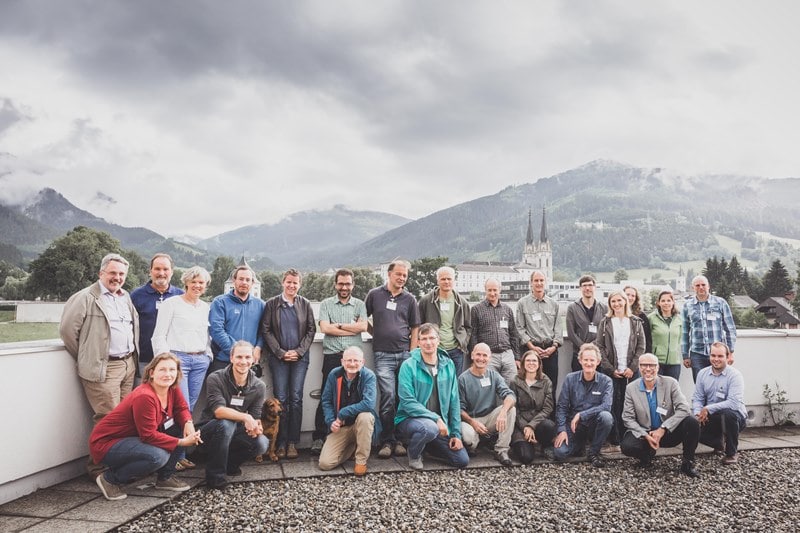
28.06.2018
Expedition_Heimat was launched by the Gesäuse National Park and Tourist Association and seeks answers to the question "how do we want to live?
Architecture students from Graz University of Technology spent a week in Hieflau at the invitation of the municipality and worked out proposals for the development of the village.
On 23 June, the projects were presented in the Schneckenhaus, they will be on display there until October. The proposals revolve around the creation of a central town square, conversion of the Kinderfreunde home, traffic calming and nature experience in the immediate vicinity of the village. After all, Hieflau forms the eastern entrance to the Gesäuse National Park.
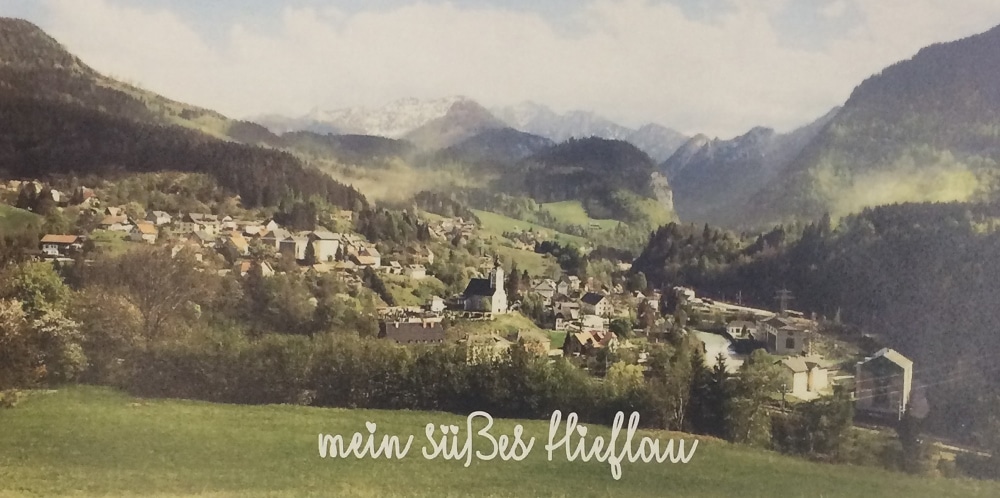
15.06.2018
The Gesäuse is Austria's endemic hotspot! In the recently completed LE project "Protected Property Inventory Gesäuse", it was confirmed that in no other spot in Austria are more small-scale and thus globally unique animal and plant species to be found than in our National Park. For this biological finding, dozens of researchers were on the move for 5 years in the heights and caves, forests and meadows between Admont and Hieflau.
The number of endemic species currently recorded here for the Eastern Alps has grown to over 240. Of these, 30 species belong to the plant kingdom, 210 species to the animal kingdom; these are exclusively invertebrates. Of these, the largest proportion is made up of beetles with 70 species, followed by snails (33) and spiders (22). Our research team will take a closer look at the threats posed to these unique creatures by climate change.
More at: http://www.nationalpark.co.at/de/forschung/veroeffentlichungen/wirbellose-tiere
To the illustration: Surviving the ice ages for thousands of years, only brought out of its scientific baptism 50 years ago and today a flagship of the endemics in the National Park - the subalpine cave canopy spider, Troglohyphantes subalpinus (Illustration: Miriam Frutiger)
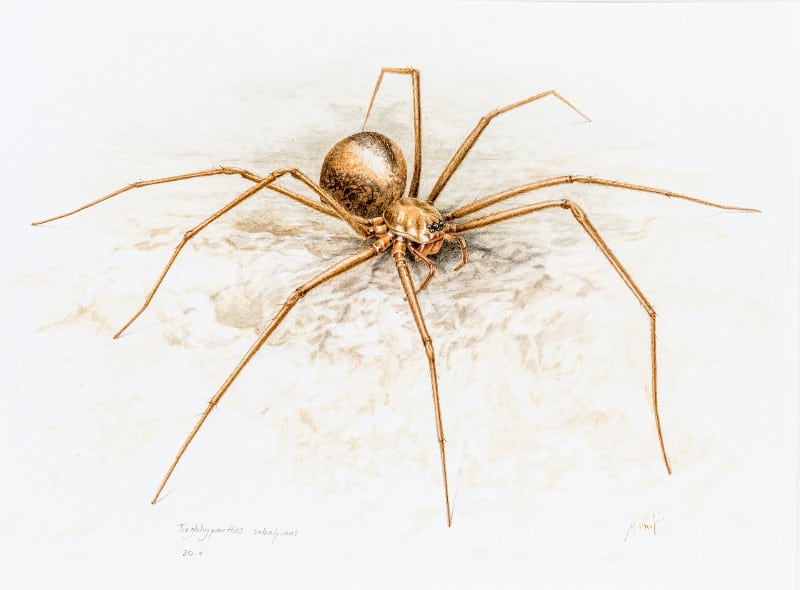
08.06.2018
The majority of bees - especially in the cultivated landscape - are provided by the state-building honey bee. It is easy to overlook the fact that there are over 113 species of wild bees buzzing around the Gesäuse National Park. From the dark curly sand bee, which already flies in spring, to the winged cone bee, which is threatened with extinction, many species surprised us during the 10 years of research.
In times of increasing awareness of the importance of "wild pollinators", it is significant to know the regional hotspots of bee and wasp species and to allow for the dynamics of habitats - whether shaped by avalanches or rivers or other abiotic factors. For it is precisely the lack of dynamics that threatens these species in intensively used areas. Yet wild bees, i.e. bumblebees, wasps and bees, two-winged flies such as hoverflies and various butterfly species, are indispensable pollinators for a large proportion of crops and wild herbs.
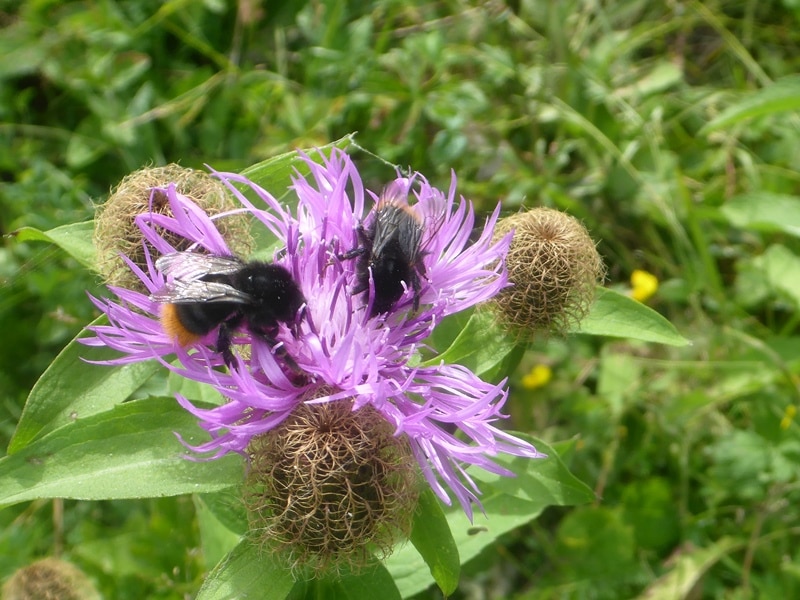
06.06.2018
We are always pleased to guide special guests through the National Park. In spring, we had the pleasure of welcoming the following delegations, among others:
Svetlana Belova with staff from various Russian national parks
Markus Niemelä with foresters from Finland
Nature Conservation Officer of the Military Command Styria
Mathias Schickhofer with Mihai Gotiu (Vice President of the Romanian Senate) and Gabriel Paun (Agent Green)
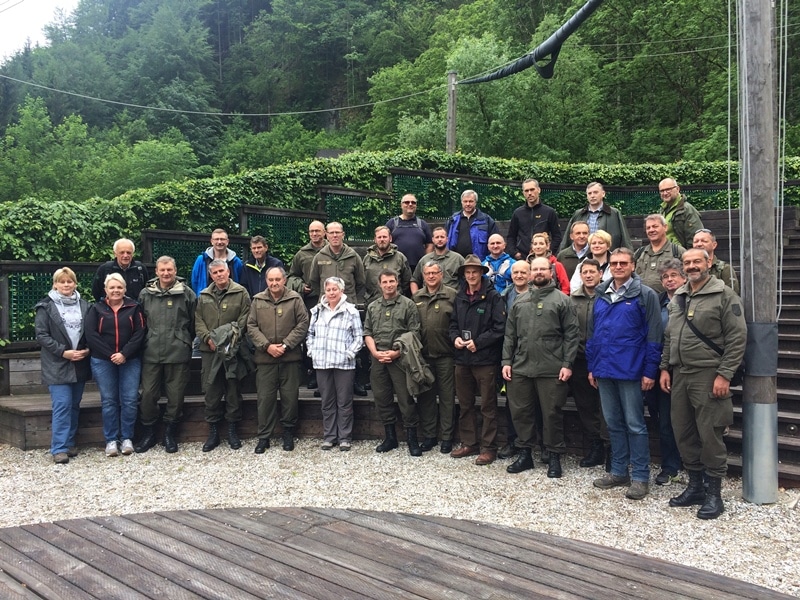
02.05.2018
It's summer and the summer issue of our magazine "Im Gseis" is fresh off the press. The National Park Magazine is published twice a year and informs about the work in the only National Park in Styria. For all those who would like to read issue 30 in advance - the online version is available for download on our website!
You can also subscribe to the magazine free of charge: Simply send an e-mail with your name and address to Karin Lattacher - karin.lattacher@nationalpark.co.at or a fax to +43 3631 21000 18.
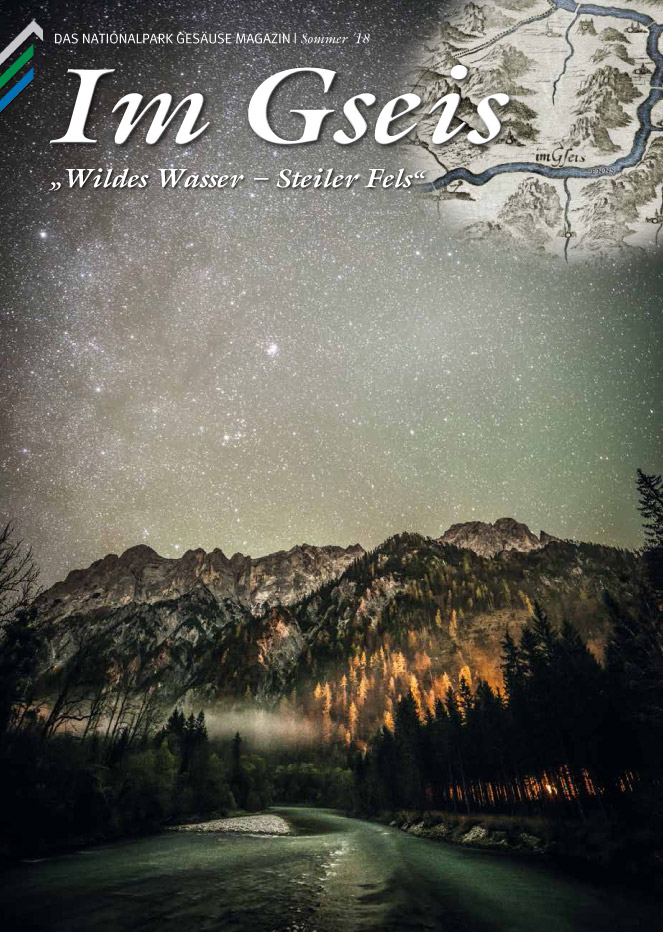
18.04.2018
With the Light Photo Summit, Admont will once again be put in the light of nature photography at the end of April. The first action is a photo exhibition in the Eichelau (near Volkshaus and Hotel Spirodom).
Life-size photos show brown bears in their native forests. As befits bears, outdoors of course. Christine Sonvilla and Marc Graf are photographing these brown bears in Slovenia as part of their project "Living at the Limit".
www.lebenamlimit.at
Thanks are due to Technicomp and Canon for supporting the exhibition.
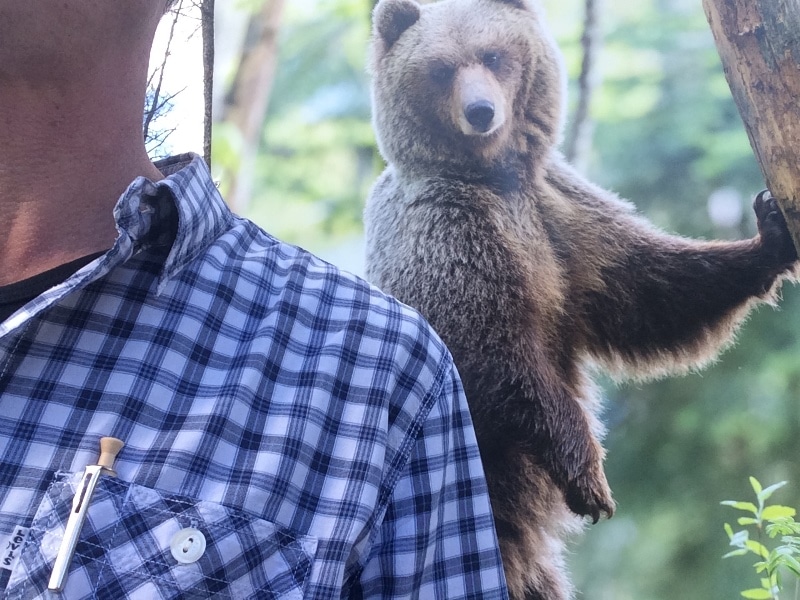
08.03.2018
Not only bark beetles belong to the wood-dwelling (=xylobiont) beetles. In total, 180 beetle species belonging to the xylobiont beetles have been identified in the Gesäuse National Park in a current project.
Of these, 20 are on the Red List of endangered beetles in Austria. Four species are considered primeval forest relict species, including the hunting beetle Peltis grossa, or the alpine longhorn beetle (Photo: Michael Gräf). These species need a lot of old and dead wood in the forest. Protected forest areas, such as the Gesäuse National Park, are therefore important for their long-term survival.

08.03.2018
In recent years, one native deciduous tree species has been affected by enormous losses: the ash. What is there to say about this, where does science stand today, how should landowners behave?
Further information on National Park Radio: https://cba.fro.at/370000
The ash tree on Youtube: https://www.youtube.com/watch?v=zW8-PkC_uPI
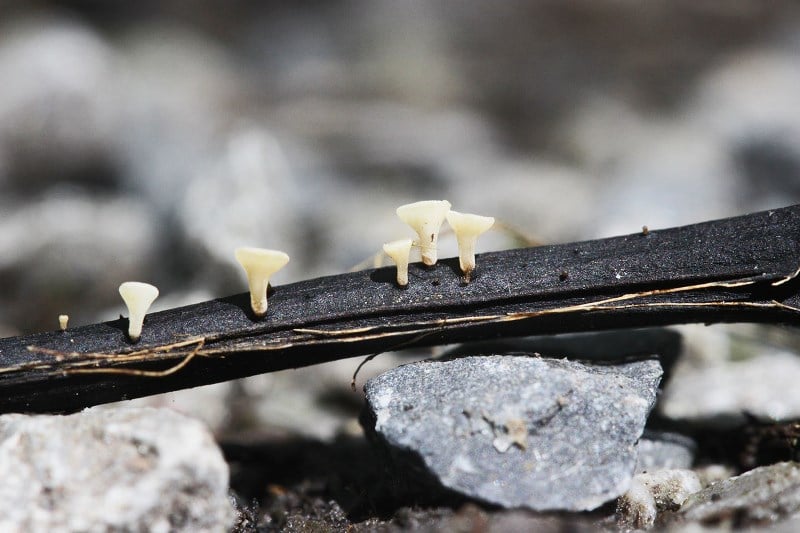
31.01.2018
From 25 to 28 January 2018, the 23rd International Ranger Olympics - the "Memorial Danilo Re 23°" - was held in the Berchtesgaden National Park in the Bavarian Alps. In memory of an Italian National Park employee, this Alpine-wide meeting is held annually in different protected areas and offers not only technical lectures and a social exchange of rangers and protected area employees, but also a friendly sporting competition.
In the "Trophy Danilo Re", teams from the protected areas of all the countries bordering the Alps compete in the following sporting disciplines: ski mountaineering, giant slalom, cross-country skiing and shooting. Four participants per team compete in one discipline for the best possible results, which are added up at the end and result in the overall ranking. This year a total of 46 teams from seven countries took part (participation record!), including a team from the Gesäuse National Park and a "mixed team" together with rangers from the neighbouring Kalkalpen National Park. In the end, the team from the two national parks came 32nd and a sensational 12th, which was a justifiable reason to celebrate in view of the many professional athletes at the start!
For years, the "Memorial Danilo Re" has been an important opportunity for the employees of the Alpine protected areas to meet, especially those who are entrusted with monitoring, care and knowledge transfer in the area on a daily basis. The Memorial stands for friendship and the collaborative efforts and goals of all those working in the protected areas.
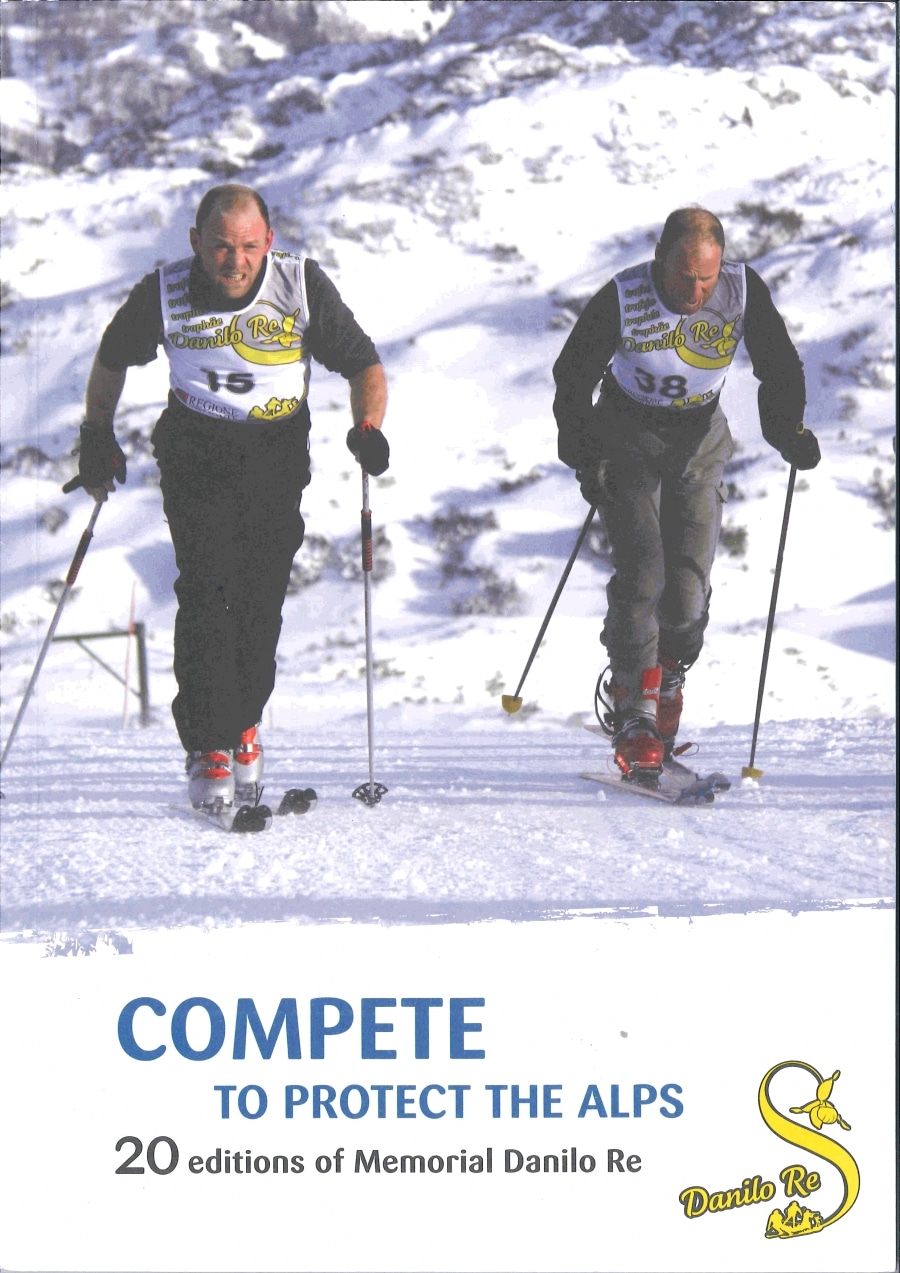
23.01.2018
In the Kalkalpen and Gesäuse National Parks, winter is still as you would imagine - with snow and cold. Many things can be experienced: Red deer feeding in the Bodinggraben in the Kalkalpen or snowshoe hikes the search for animal tracks in the winter forest...
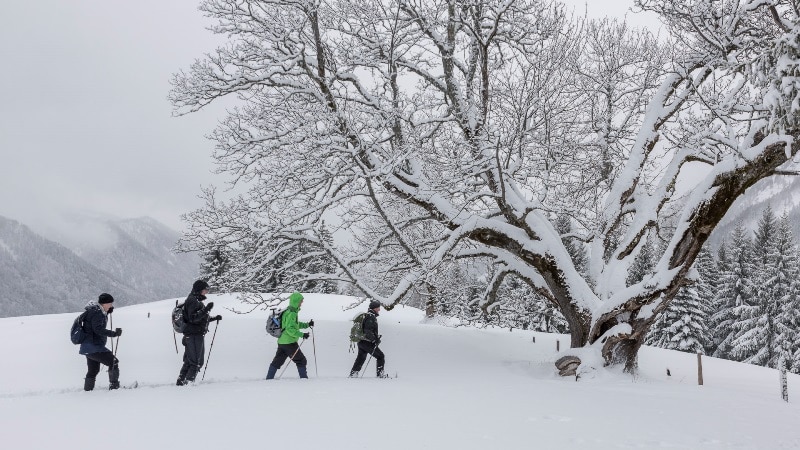
16.01.2018
Active in all weathers and seasons. Photo traps are now a common method of tracking rare species, such as the lynx.
The cameras record exciting moments in the lives of our wild animals and so the GRAWE sidebyside youth advisory board of the Gesäuse National Park began to deal with the topic at the end of 2017. The purchase of three new photo traps was decided and financed. Many thanks to the sponsor GRAWE and the members of the youth advisory board for their commitment!

15.01.2018
The rangers and organs of the Gesäuse National Park are also out and about in the terrain in winter. A solid knowledge of the dangers in winter and the right action to take in an emergency are basic prerequisites for their work. In order to regularly refresh their knowledge, there is an annual avalanche course for National Park staff, rangers and authorities.
Under the guidance of René Guhl (Bergpuls Mountain School) and Stefan Leitner (Berggfühl Mountain School), the knowledge of theoretical avalanche awareness was deepened and the use of beeps, shovels and probes was trained. On the practical day, the participants went out into the terrain, where they intensively dealt with the assessment of avalanche danger.

15.01.2018
The new issue of the "Journal of protected mountain areas research and management" has been published. eco.mont is backed by the Alpine Network of Protected Areas (ALPARC), the International Scientific Committee on Research in the Alps (ISCAR), the Austrian Academy of Sciences (ÖAW) and the University of Innsbruck.
Printed editions are available on the UIBK site.
You can find the online edition on the austriaca.at site.
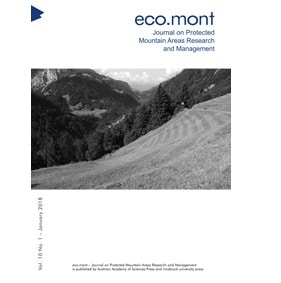
15.01.2018
The next birthday is sure to come and a suitable gift would be a voucher for a national park event or something from the shop in the information office. The value is freely selectable!
valid for individual guided tours "Book your guide
valid for a purchase in the Info Shop in Admont
valid for guided tours according to the event programme
